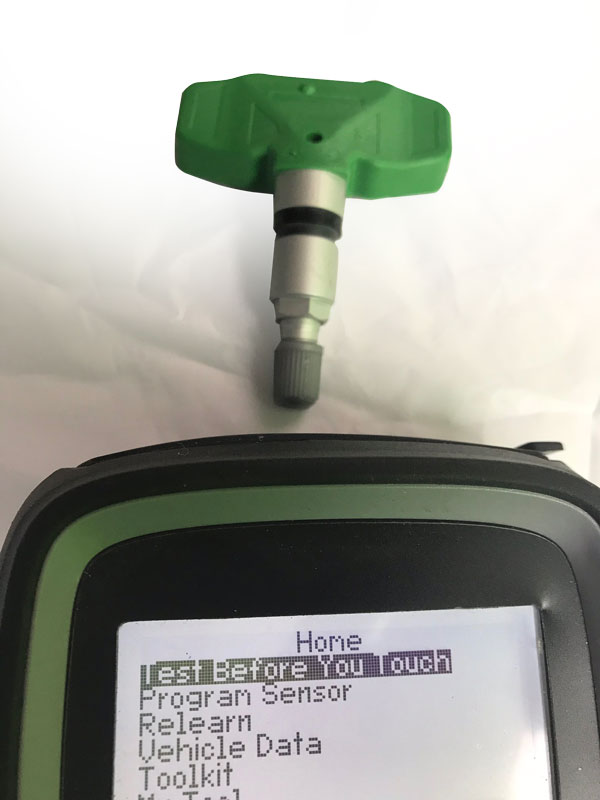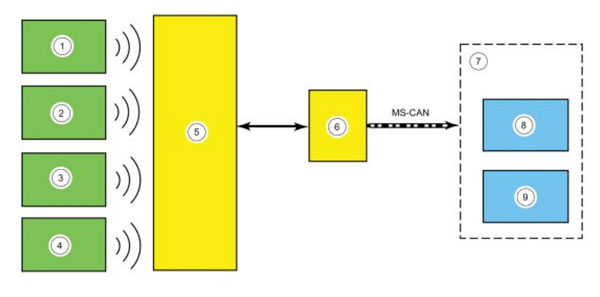
The first step in any TPMS diagnostic strategy is to figure out whether or not your customer’s vehicle actually has a TPMS problem. Why? Simply put, there are a number of factors that can cause a TPMS warning light to illuminate or flash – and some are hard to uncover.
The light should illuminate when a tire is low (25% below the OEM-mandated inflation pressure) and should eventually go out after the low tire has been inflated to its proper pressure. This past winter season left a few heads shaking when drivers saw the TPMS light illuminate on cold mornings only to go out once the tire was warmed up during normal operation.
Of course, extreme cold is the exception. In normal operation, if the light remains on after checking/inflating the tires, or if it flashes and remains illuminated, it may signal a TPMS problem that will require further diagnosis.

TPMS problems can include any of the following:
• A TPMS sensor has stopped functioning because its battery has died.
• A TPMS sensor is working intermittently due to a weak or failing battery.
• A TPMS module is not receiving signals from one or more sensors because of an antenna or wiring fault.
• A TPMS module is not functioning properly or has failed because of a voltage supply, wiring or internal electronics fault.
• The relearn procedure not being done correctly after a tire rotation or other service.
• The vehicle’s owner not understanding how the TPMS works.
STEP-BY-STEP
One of the diagnostic mantras preached by service experts today is “test before you touch.” You should always use a TPMS tool to activate and check the response signal from each tire pressure sensor in each wheel before you do anything else.
This will tell you:
Whether or not each sensor is capable of generating a signal; and
If the sensor is generating a signal, whether or not the pressure reading is accurate.
The pressure reading from a sensor can be easily verified by checking the actual pressure in the tire with a gauge. If the pressure value displayed on your TPMS tool reads a certain inflation pressure (psi or bars), you should find that same inflation pressure when you check with a proper gauge.
Your tire pressure gauge must be accurately calibrated. Those cheap spring-loaded stick-style tire pressure gauges can vary up to 5 psi or more. Digital gauges are the most accurate because many have a self-calibrating feature that compensates for changes in ambient air temperature.

Part of the diagnostic process is knowing How information from the sensors is received and shared between the modules.
BAD VALVES, AGING SENSORS
Watch for corroded or damaged TPMS valves. The valve stem on each wheel should be visually inspected for corrosion or other damage that might affect its integrity. Certain makes and models of vehicles have gained notoriety for suffering excessive corrosion even to the point that valve-stem sensors literally fall into the tire, causing instant deflation.
Consider the age and mileage of the vehicle when doing your diagnosis. The average life of the battery inside a brand new factory TPMS sensor is around seven years, depending on use. The more the vehicle is driven, the more often the TPMS sensors generate their signals, and the faster they use up their remaining battery life.

HOW TO PROCEED
If you find a tire pressure sensor that is not functioning or reading accurately, the natural assumption is that the sensor is the problem and replacing the sensor will fix the issue – and usually it will. But until you check the rest of the system, there’s no guarantee a bad sensor is the only problem affecting the operation of the TPMS.
If all of the sensors appear to be working normally and all of the tires are inflated to the recommended pressure, but the TPMS warning light remains on or flashing, you’ll have to dig deeper to uncover the fault.
For the next step, you’ll need a TPMS tool or scan tool that can communicate with a TPMS system via the OBDII diagnostic connector under the instrument panel. After plugging in your tool, read out any fault codes that are found and write down the code(s) so the information isn’t lost when you clear the module’s memory.
You might find a code indicating one or more bad tire pressure sensors because there is no signal being received from those sensors. But, if you already checked each sensor with your TPMS tool and didn’t find any problems, you know the problem isn’t the sensors. Consequently, the only explanation is that the sensor signal is not getting through to the TPMS module. The problem could be a damaged or shorted antenna near the wheel or a wiring fault between the antenna and the TPMS module.
If you suspect the TPMS module is not receiving a good signal from one or more sensors, check the antenna wiring for continuity and problems such as shorts, opens or high resistance. A voltage drop test across any wiring connections should read 0.10 volts or less. A higher voltage drop reading indicates excessive resistance that is affecting the quality of the signal.
If the antenna wiring checks out, but the TPMS module is still generating a “no sensor signal” code, the fault is likely within the module itself. But, before you condemn the module and tell your customer the TPMS module needs to be replaced, make sure you check the TPMS module voltage supply and ground connections because low voltage can make any electronic module misbehave and act quirky.
On some vehicles, the signals to the TPMS module are shared or go through the keyless entry system, so a wiring problem that affects the keyless entry system could cause a problem with the TPMS. The TPMS module may be working fine, but is not getting the right information from the keyless entry system. For that reason, always look up OE service information for the vehicle to understand how the TPMS operates – especially if you are having difficulty figuring out a problem. Something else that can cause a TPMS to malfunction or set false codes is electromagnetic interference (EMI). EMI from another source might be messing with the TPMS signals and confusing the system.
Electrical crosstalk between adjacent wiring circuits can occur when the magnetic field around a wire that runs parallel to another wire induces a current in the second wire.
Article courtesy Brake & Front End.













